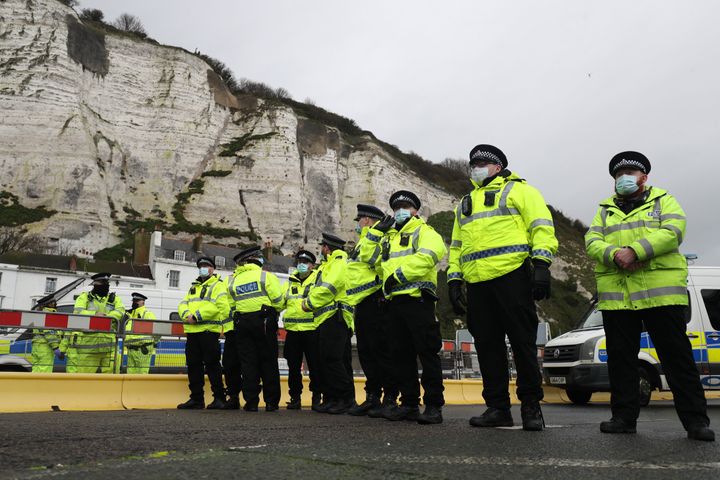Matt Hancock has announced more areas of England will be placed under tier 4 restrictions in an effort to slow the rapid spread of a new mutant strain of coronavirus.
The health secretary said Covid-19 is spreading at a “dangerous rate” across large parts of the country and also revealed a new “concerning” and “more transmissible” variant from South Africa has been detected in the UK.
Publicly available data paints a grim picture of the current situation in England with cases rising in most areas at alarming rates.
And on Wednesday afternoon it was announced the UK’s coronavirus R (reproduction) rate has risen once again to between 1.1 and 1.3.
Last week the value stood at 1.1 to 1.2.
The data below is taken from NHS Digital and relates to the seven-day period up to December 20.
1) Cases have more than doubled in some of the worst hit areas
For context, the government’s own threshold for quarantining overseas travellers is 20 cases per 100,000 people over a seven-day average.
Brits visiting countries with higher case rates are required to quarantine for 10 days upon their return.
Currently in England the region with the highest case rate is Thurrock with a staggering 1,198.8 cases per 100,000 people.
Not a single area of the UK is below the threshold of 20. The lowest is Torbay at 71.2.
20 worst hit areas
- Thurrock 1,198.8
- Havering 1,111.1
- Redbridge 991.4
- Medway 970.0
- Barking and Dagenham 899.0
- Southend-on-Sea 893.9
- Bexley 852.6
- Waltham Forest 809.8
- Newham 746.5
- Tower Hamlets 735.3
- Enfield 734.0
- Essex 706.0
- Kent 663.3
- Bromley 642.1
- City of London 641.9
- Milton Keynes 626.8
- Haringey 626.5
- Greenwich 572.3
- Croydon 559.9
- Wandsworth 557.2
2) The handful of areas in tier 1 have seen a massive increases in cases
Only three areas of England were under the lowest tier 1 restrictions and these now account for the regions with the highest increase in cases – the Isle of Wight, Cornwall and Isles of Scilly and Herefordshire.
The Isle of Wight along with Cornwall and the Isles of Scilly had fared relatively well in terms of infection rates.


Just last week the latest data showed both areas had case rates just above the travel corridor threshold of 20 per 100,000 people – 21.2 and 29.7 respectively.
These have since surged. In the Isle of Wight cases have risen 323% to 89.6 and in Cornwall and the Isles of Scilly by 117% to 74.3.
Hereford, the only other area in tier 1, case rates have risen 114% from 51.3 to 126.6.
Largest increase in cases
- Isle of Wight 323% (89.6 cases per 100,000)
- Cornwall and Isles of Scilly 117% (74.3)
- Herefordshire 114% (126.6)
- Islington 106% (534.5)
- Southhampton 104% (209.9)
- Southend-on-Sea 104% (893.9)
- York 103% (140.5)
- Hammersmith 94% (465)
- Torbay 94% (71.2)
- Westminster 94% (367.4)
3) Cases are rising in all but two tier 2 areas
Of 27 areas currently under tier 2 restrictions, only two have seen a decrease in cases – Rutland and Shropshire -33% and -11% respectively.
Some tier 2 areas have seen huge surges with cases more than doubling in Southampton and York.
Worst hit tier 2 areas
- Southampton 104% (209.9)
- York 103% (140.5)
- Brighton and Hove 84% (218.3)
- East Sussex 76% (478.1)
- Dorset 68% (83.7)
- Hampshire 67% (202.6)
- West Sussex 66% (202.7
- Liverpool 66% (165.6)
- Bournemouth 64% (151.0)
- Oxfordshire 61% (246.1)
- Cumbria 53% (164.4)
- Cheshire 46% (207.2)
- Warrington 46% (246.7)
- Norfolk 46% (189.6)
- Suffolk 39% (171.9)
- Cambridgeshire 38% (162.7)
- Somerset 35% (169.9)
- Northamptonshire 31% (228.9)
- Devon 31% (128.2)
- Swindon 25% (173.3)

4) Of 151 regions in England, cases are only going down in 23
There are 151 areas listed on the NHS dashboard and only 23 have seen a decrease in cases over the last seven days, most of them in the North and Yorkshire.
Of these, only two – Rutland and Shropshire – have seen the case infection rate drop below 100 per 100,000 people.
The biggest decreases in cases
- Rutland -33% (92.7)
- Wigan -18% (144.5)
- Redcar and Cleveland -16% (119.6)
- Lincolnshire -14% (225.7)
- Rochdale -13% (189.7)
- South Tyneside -13% (281.5)
- Sheffield -13% (133.9)
- Bradford -12% (157.1)
- Blackpool -11% (146.3)
- Shropshire -11% (87)
- North East Lincolnshire -11% (106.5)
- Newcastle upon Tyne -10% (138)
- Doncaster -10% (179.9)
- Kirklees -9% (149.4)
- Rotherham -9% (218.5)
- Bury -9% (195.8)
- East Riding of Yorkshire -8% (130.1)
- Calderdale -6% (150.4)
- Stockton-on-Tees -6% (189.5)
- Bolton -3% (144)
- Wakefield -2% (151.3)
- Oldham -2% (183)
- Stoke-on-Trent -2% (312.4)
5) Hospitalisations are not rising as fast as infections – yet
Government data show a steady uptick in hospitalisations over the last few days with 1,327 people being admitted to hospital on the 21 December.
This compares with a peak of around 2,800 daily admissions at the height of the first wave in April.

What’s concerning is the lag between cases being detected and symptoms becoming severe enough to require hospital treatment – typically there is a lag of a few weeks between people testing positive for the virus, then a rise in hospitalisations, and then a rise in deaths.
On Tuesday 405 Covid deaths in English hospitals were recorded, the deadliest day of the entire second wave. In total, there were 691 deaths recorded in the UK.
According to the most recent figures published by the Office for National Statistics (ONS), the number of excess deaths that have occurred in the UK since the start of the coronavirus pandemic has now passed 80,000.

